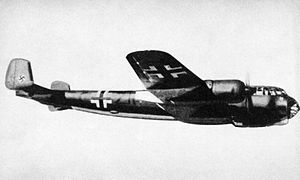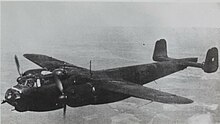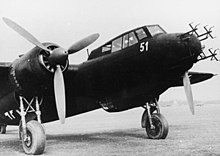Dornier Do 217
| Dornier Do 217 | |
|---|---|
 Dornier Do 217E-2 |
|
| Type: | bomber |
| Design country: | |
| Manufacturer: | |
| First flight: |
October 4, 1938 |
| Commissioning: |
1940 |
| Production time: |
1940 to 1943 |
| Number of pieces: |
1925 |
The Dornier Do 217 was a twin-engine bomber produced by the German Dornier works . It was in use from 1938 until the end of the Second World War .
development
The design of the Do 217 was based externally on the Dornier Do 17 , but was largely a new development. This development differed in terms of more powerful engines, a higher flight weight, automatic dive protection, an enlarged wing area, a larger fuselage, a reinforced landing gear , hot air de-icing , electrics instead of hydraulics, improved trim for single-engine flight and new detailed designs. It had seven main assemblies, the Do 17 only four. Nine prototypes were built and tested in various configurations that are continuously being developed.
The first six prototypes were equipped with an umbrella-like dive brake at the stern, but this did not work reliably. The first unarmed prototype Do 217 V1 flew for the first time on October 4, 1938, but crashed on October 11, 1938 when attempting a dive. The ninth prototype Do 217 V9 then formed the model aircraft for the Do-217E series.
commitment
From 1939 to the end of 1943, a total of 1925 Do 217s of all variants were built for the German Air Force , and in 1944 a few modifications were made for special requirements. The Kampfgeschwader 40 and Kampfgeschwader 100 used the Do 217 primarily for fighting ships. The kampfgeschwader 100 led to this end, the glide bomb Hs 293 and for the first time nachsteuerbare unguided bomb Fritz X with. A Do 217K-2 of this squadron sank the battleship Roma on September 14, 1943 from a height of 6400 m . It was also used as a carrier aircraft for the DFS 228 high-altitude reconnaissance aircraft and as a test vehicle for the ramjet engine by Eugen Sänger . From the beginning of 1944, the Do 217 were replaced by other models and given to flight schools or scrapped. Only with Nachtjagdgeschwader 4 were Do-217 night fighters used until mid-1944. The Do 217 was still used as a bomber in Kampfgeschwader 2 , for example with the Steinbock company , where the I. and III. Group was equipped with 35 and 38 Do 217E respectively. The deployment as a long-range reconnaissance, however, took place in the night reconnaissance group 5 until the end of the war. Some Do-217J night fighters were handed over to Italy in 1943.
Versions
Small series, prototypes
- Do 217A : pilot series of nine machines with two DB-601B -V12 engines, used as prototypes, serial number (material number) 2701–2709
- Do 217C : pilot series of nine machines, used as reconnaissance aircraft, mat. 2710-2718
- Do 217H : Conversion of three aircraft (W.-No. 21-23)
- Do 217P : Conversion of six aircraft, intended as high-altitude aircraft with a pressurized cabin and DB 605 T loader engine in the fuselage (W.-No, 1229, 24–28), at least four flown in by November 1942
- Do 217R : Conversion of four aircraft planned (W.-Nr. 29–32), flown in until November 1942
- Do 217G : Project of a “sea stuka ” with swimmers
- Do 217W or Do 216 : torpedo bomber project with double swimmers .
High volume versions
- Do 217E : First major series version, the E series was powered by two air-cooled BMW 801 twin radial engines, each with 1560 hp starting power; initially the 801A was used and later the improved 801L with the same performance. It was used in the Luftwaffe as a reconnaissance aircraft , bomber and torpedo bomber from 1941 . The E-5 was armed with the Hs-293 glider bomb.
- Do 217K : As Do 217E, but completely redesigned bow section with enlarged and widened fuselage cross-section and large-scale glazing, two BMW 801L double radial engines with 1560 hp starting power each. The K-2 had an enlarged wingspan (20.81 m) in order to be able to carry the Fritz-X glide bombs.
- Do 217M : Instead of the air-cooled double radial engines, the Do 217M had two water-cooled DB-603A V12 engines with 1750 HP starting power each. Otherwise it was largely identical to the Do 217K. The maximum speed was 556 km / h and the maximum bomb load was 4000 kg.
- Do 217J : Night fighter based on E-Version bombers, solid nose with four 20 mm MG FF / M cannons and four 7.92 mm MG 17 machine guns . The J-1 could also carry a low bomb load, the J-2 had additional tanks in the bomb bay.
- Do 217N : The Do 217N was developed from the M version bomber to meet the requirements of a night fighter. It was used exclusively to intercept Allied bombers over Germany. The Do 217N was a fast and stable weapon platform and ideally suited for instrument flight, but made quality demands on the pilots. A total of 325 Do-217N night fighters were delivered to the Air Force. In the case of the N-2, various items of equipment for carrying bombs and the C-Stand were omitted, but two or four MG 151/20 20 mm cannons were usually carried as " weird music ". As with the Do 217J, the weapons in the nose were initially four MG FF / M and MG 17s, with the Do 217 N-2 the MG FF / M were replaced by the more powerful MG 151/20 of the same caliber. This made the ammunition supply easier, especially for machines with MG 151/20 as “weird music”. The FuG 202 "Lichtenstein B / C", the FuG 212 "Lichtenstein C-1" and later partly also the FuG 220 "Lichtenstein SN-2" were used as radar , the FuG 350 "Naxos-Z" as a passive radar receiver was used in the Do 217 is rarely installed.
production
The Do 217 was built in series from November 1940 to May 1944, but not all aircraft with engines could be delivered in 1943 (a total of 395 aircraft). These were partially retrofitted as soon as the DB 603 was available and partially scrapped (around 125 aircraft). The aircraft was only built in series in the three Dornier plants in Dornier Friedrichshafen (DWF, 335 aircraft), Dornier Munich ( Neuaubing DWM plant, 990 aircraft) and North German Dornier Wismar (NDW, 600 aircraft). Production at Dornier Friedrichshafen ended in December 1942, and in Wismar (NDW) in October 1943.
| version | DWF | DWM | ND W | total | comment |
|---|---|---|---|---|---|
| Prototypes | 4th | 4th | |||
| A-0 | 9 | 9 | |||
| C-0 | 9 | 9 | |||
| E-1 | 44 | 50 | 94 | ||
| E-2 / E-4 | 129 | 300 | 200 | 629 | |
| E-5 | 67 | 67 | Missile carrier | ||
| E-5 | (34) | (34) | Conversion from E-4, guided weapon carrier | ||
| J-1 | 130 | 130 | Night fighter | ||
| K-1 | 220 | 220 | |||
| K-2 | (50) | (50) | Conversion from K-1, guided weapon carrier | ||
| K-3 | (40) | (40) | Conversion from M-1, guided weapon carrier | ||
| M-1 | 258 | 180 | 438 | Bomber with DB 603 | |
| M-11 | (37) | (37) | Conversion from M-1, guided weapon carrier | ||
| N-1 / N-2 | 10 | 315 | 325 | Night fighter with DB 603 | |
| H | (3) | (3) | modification | ||
| P | (4) | (4) | modification | ||
| R. | (4) | (4) | modification | ||
| total | 335 | 990 | 600 | 1925 |
Technical specifications
| Parameter | Do 217 V4 | Thu 217E-2 | Thu 217P |
|---|---|---|---|
| crew | 4th | ||
| length | 18.10 m | 18.2 m | 16.80 m |
| span | 19.00 m | 24.50 m | |
| height | 4.8 m | 5.03 m | 5.00 m |
| Wing area | 57 m² | 71 m² | |
| Wing extension | |||
| payload | |||
| Empty mass | |||
| Max. Takeoff mass | 10,500 kg | 15,965 kg | 15,965 kg |
| Marching speed | |||
| Top speed | 460 km / h | 515 km / h | 533 km / h |
| Service ceiling | 7900 m | 9000 m | 13,500 m |
| Range | |||
| Ascent time to 5000 m | 18 min | ||
| Engines | two Jumo 211B each with 1200 HP takeoff power |
two 14-cylinder double radial engines BMW 801L each 1560 hp starting power |
two DB 603B each 1750 hp takeoff power |
literature
- Documents from the Federal Archives-Military Archives Freiburg im Breisgau and the National Archives , Washington, United States.
- A documentation on the history of the Dornier company, published by Dornier GmbH, 1983, 214 pages bound.
- Olaf Groehler : History of the Air War 1910 to 1980. Military publishing house of the German Democratic Republic, Berlin 1981.
- Kenneth Munson: Bombers, Patrol and Transport Aircraft 1939–45. Orell Füssli Verlag, Zurich, 3rd edition 1977.
Web links
Individual evidence
- ^ Heinz J. Nowarra : The German Air Armament 1933-1945. Volume 1, p. 213.
- ↑ Ulf Balke: The aerial warfare in Europe 1939-1941 . Bechtermünz Verlag, Augsburg 1998, ISBN 3-86047-591-6 , p. 390 (1057 pp.).
- ^ Alfred Price: Dornier's Welterweight. In: AIR International. September 1993, p. 151.
- ↑ Do 217 N-2 Operating Instructions-Wa, March 1943, L.Dv.T.2217 N-2 / Wa




